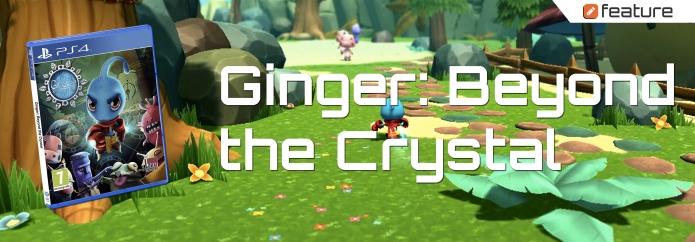From your first introduction to Ginger and the world he inhabits, it’s clear that Ginger: Beyond the Crystal draws heavy inspiration from some of the best 3D platformer franchises of all time. Staples of the genre like colorful environments, charming NPCs, and challenging platforming elements return, but so do tedious collect-a-thons, a barely-there story, a camera that proves very difficult to control, and a framerate that leaves a lot to be desired. With Ginger, Drakhar Studio did not improve on the formula established by the franchises that inspired it, and because of that, we’re left with a fun experience that feels distinctly dated. If you’re looking for a deep experience, look elsewhere, but if you’re looking for a fun way to satisfy your insatiable thirst for nostalgia until Yooka-Laylee comes out in March, Ginger: Beyond the Crystal does the trick nicely.
The entire story of Ginger: Beyond the Crystal is told in a 4-minute movie before the player ever takes control. Essentially, Ginger has been tasked with collecting all the crystal fragments scattered throughout his world in order to give power back to the goddess that protected his town. It’s as bland as it sounds, and there’s not much to say about it. If you’re playing this game, you’re doing it for the gameplay. Thankfully, the gameplay is fun enough; it’s just not that deep. There are three distinct elements to this game that all play uniquely: three overworlds, fifteen levels with a fixed camera that require simple combat and platforming, and fifteen levels with a user-controlled camera that require platforming that’s a bit more complicated.
The fifteen levels with a fixed camera are full of mindless fun. The platforming is mindless, the combat is mindless, but the overall package is still rewarding enough thanks in no small part to the varied environments and ridiculous NPCs. One of the standout levels consists of Ginger playing hide ‘n’ seek with a headless butler in a haunted mansion, while another consists of Ginger racing against time to stop a self-destruct sequence on a rocket ship crewed by imitation Minions. There’s a serious amount of charm here, but these levels are held back by shallow combat that never evolves. In the beginning tutorial, the player learns of Ginger’s standard and special attacks. Neither seems to be more powerful than the other, but the special attack misses all the time, whereas the standard attack nearly never misses. Players will find themselves resorting to the standard attack for the entire game. Ginger can acquire special outfits that grant new abilities (think Mumbo Jumbo transformations from Banjo Kazooie), but none of these outfits result in new or novel ways to fight. Even though the dragon suit allows Ginger to breathe fire, he can’t use it to attack enemies. He can only breathe fire to destroy certain objects that impede his progress.
In stark contrast, the other fifteen levels with a user-controlled camera have no NPCs, have no combat to speak of, and share one bland rocky environment throughout. Still, they are the most satisfying part of the entire game because they offer the one thing the rest of this game does not: a challenge. These levels consist of a series of floating, rotating, rectangular rocks that Ginger must jump across with the end goal of simply making it to the other side to retrieve a crystal. Each level gets gradually harder, and more rewarding. Some of that challenge results from an unwieldy camera, but not enough to ruin the experience. Still, this is nothing players haven’t seen before.
The overworlds are where this game stumbles hardest. As Ginger, the player is tasked with rebuilding the townspeople’s houses by collecting raw materials through quests given by those same townspeople. The problem is that there are only three different kinds of quests, all of which are repeated countless times. You’re either defeating a group of five enemies, collecting three random collectibles throughout the town (they are marked on your map so there is no challenge here), or completing a race by hitting every checkpoint in an allotted amount of time. These quests are boring, but are necessary to open up new levels in which to play. Ultimately, these quests serve as an unnecessary barrier to entry to the portions of this game that are actually fun.
Ginger: Beyond the Crystal is at times absolutely gorgeous. Its bright colors, cartoonish aesthetic, fantastical environments, and delightful soundtrack are reminiscent of some of the best 3D platformers on the Nintendo 64. Unfortunately, Ginger’s framerate can dip low enough to be reminiscent of those games as well. Most of the time it hovers around 30 fps, but it’s inconsistent. Thankfully, this rarely affects gameplay, mostly just causing stutters in the transition from overworld to level. Speaking of those transitions, load times in this game are absolutely atrocious. Again, this does not affect gameplay, but it does compound the already annoying framerate issue.
BROPINION
If you’re a fan of the 3D platformer genre, and you can forgive technical issues that don’t really affect gameplay, Ginger: Beyond the Crystal is worth checking out. Just don’t expect a game that will move the genre forward. For better or worse, it’s stuck in the past.
